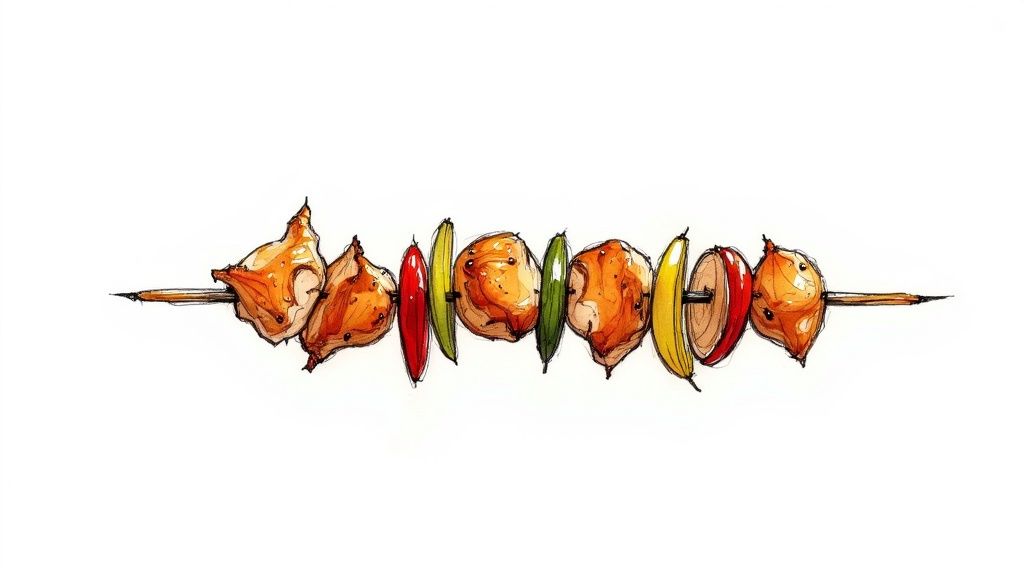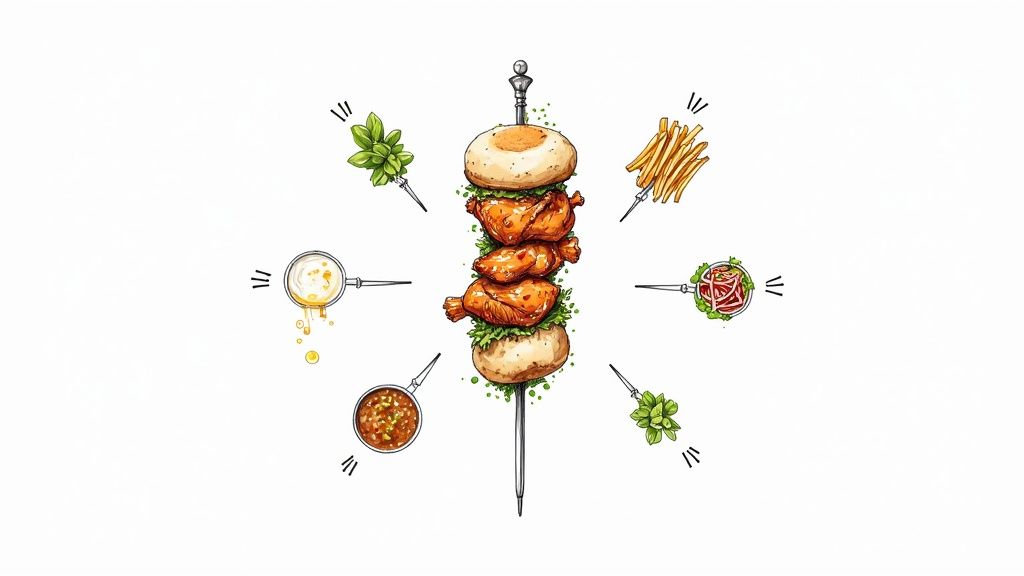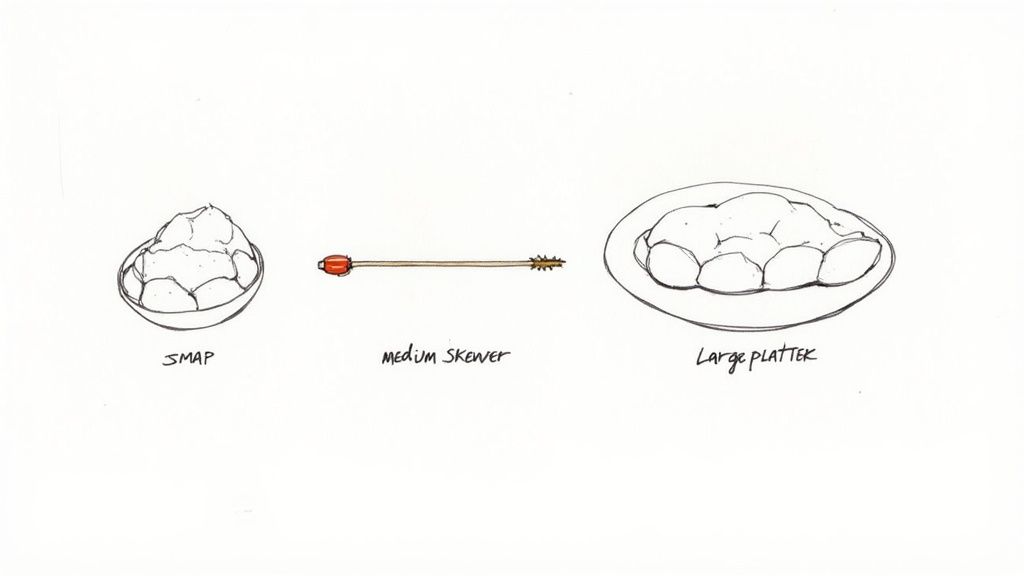Chicken Kebab Nutrition: A Simple Guide to Your Go-To Meal
Explore our simple guide to chicken kebab nutrition. Learn about calories, protein, and macros to enjoy your favorite meal while easily tracking your goals.
Posted by
Chicken kebabs are a fantastic go-to for a high-protein meal, but let's be real—not all kebabs are created equal. A typical skewer from your favorite spot (around 180-200g) can pack a solid 35 grams of protein. But the total calories, carbs, and fats can swing wildly depending on the marinade and, of course, what you serve it with.
Think fluffy rice, warm pita bread, and all those delicious sauces. They're part of the fun, and understanding how they fit into the picture is surprisingly easy.
What's Really in Your Chicken Kebab?

So, what are you actually eating when you bite into a juicy chicken kebab? At its core, it's a lean protein champion, but the final nutritional scorecard is a team effort.
Think of it this way: the chicken brings the protein, colorful veggies add fiber and vitamins, and any rice or bread on the side handles the carbs. The fats? They mostly come from the oil in the marinade and any creamy sauces you drizzle on top. It's a simple formula you can easily tweak for a super clean meal or a more indulgent treat.
A Quick Nutrition Snapshot
To get a clearer picture, let's break down the numbers for a standard chicken kebab skewer served with sides. A serving of around 180-200 grams often lands in the ballpark of 581 calories. This typically includes about 35 grams of protein, 14 grams of fat, and 76 grams of carbohydrates, mostly from the rice or pita it’s served with. You can dive deeper into these figures by exploring detailed kebab nutrition details.
Knowing this basic breakdown helps you make smarter choices on the fly. You don't need to be a dietician to realize that swapping fries for a side salad will dramatically shift the nutritional balance in your favor.
Chicken Kebab Nutrition At a Glance
The table below gives you a rough idea of the nutritional content for common chicken kebab servings, including sides.
| Serving Size (Approx.) | Calories | Protein (g) | Fat (g) | Carbs (g) |
|---|---|---|---|---|
| 1 Small Skewer (100g) | 290 | 18 | 7 | 38 |
| 1 Standard Skewer (180g) | 581 | 35 | 14 | 76 |
| Large Plate (250g) | 750 | 45 | 20 | 95 |
These numbers are just estimates, of course, but they give you a practical starting point for tracking your meal without any stress.
Why Casual Tracking Matters
This is where casual food logging becomes your best friend. Instead of meticulously weighing every part of your kebab, you can use a tool like Munchlog.ai to get a smart estimate in seconds.
Just say it out loud: "I had one chicken kebab with pita and salad." The AI takes it from there, figuring out the likely nutrition without you having to touch a calculator.
This isn't about scientific precision. It's about building a consistent, low-effort awareness of what you're eating. It transforms logging from a tedious chore into a simple, two-second habit that keeps you in tune with your health goals without all the usual friction.
Breaking Down the Macros in Your Kebab
So, what are you actually eating when you order a chicken kebab? Let's get into the "big three" macronutrients: protein, carbs, and fat. Think of these as the core components on your plate, each playing a different role in fueling your body.
Chicken kebabs have a well-deserved reputation for being packed with protein. Protein is essential for everything from repairing muscle after a workout to simply keeping you feeling full and satisfied long after you've finished eating. It’s why a kebab feels like a real, substantial meal.
The Power Players in Your Kebab
Obviously, the chicken itself is the protein star. But what about everything else that makes up the meal?
- Carbohydrates: This is your body's go-to energy source. In a typical kebab meal, you'll find carbs in the pita bread, any side of rice, and sometimes even in the marinade.
- Fats: Healthy fats are crucial for your body. The fat content in a kebab usually comes from the oil in the marinade and, of course, any delicious sauces you decide to add.
This handy chart gives you a quick visual of what a standard chicken kebab meal looks like from a macro perspective.

As you can see, protein and carbs are often the main event, which makes for a pretty well-rounded meal that provides both lasting fullness and immediate energy. The specific cut of chicken matters, too. For those curious about the details, understanding dark chicken meat nutrition can provide an even more accurate picture.
Here’s a great stat to remember: a typical 100-gram serving of just the chicken kebab meat packs about 25.5 grams of protein but only 3.67 grams of fat. That's a fantastic lean protein source compared to many other takeout choices.
Knowing this mix helps you understand how different meals impact your body. Preparation method is a huge factor; for instance, how a kebab is cooked is very different from other methods. Our guide on is boiled chicken healthy for you dives into how cooking can completely change a food's nutritional profile.
Ultimately, a chicken kebab gives you a solid mix of fuel that’s surprisingly easy to log—especially when you can do it just by talking to your phone with Munchlog.
How Toppings and Sides Change Everything

A chicken kebab rarely travels alone. Let's be honest, the real magic happens when you start piling on the fresh salads, creamy sauces, and maybe a side of warm pita bread. These extras are what transform a simple skewer of chicken into a complete, satisfying meal.
But here’s the thing: they also have a huge impact on the final nutritional numbers. Think of your kebab as a blank canvas. Each topping you add is another splash of color, changing the final picture.
Building Your Perfect Kebab
The beauty of a kebab is that you're in the driver's seat. You can build it to be light and refreshing or rich and comforting—it's all up to you.
Here’s a quick look at what some popular additions bring to the table:
- Fresh Salads: Lettuce, tomato, and cucumber add a ton of volume, fiber, and vitamins for almost no extra calories. It’s the easiest way to make your meal feel more substantial.
- Yogurt-Based Sauces (like Tzatziki): You get that creamy texture you're craving, plus a little extra protein, for far fewer calories than a mayo-based sauce.
- Creamy Dressings & Garlic Sauce: These are undeniably delicious. They also bring more fats and calories to the party, which is perfectly fine—it’s just about being aware of it.
- Pita Bread or Rice: These are your primary carb sources, providing the energy that makes the meal feel complete. A whole wheat pita will give you a nice little fiber boost, too.
Let's break down how these choices can add up. The table below gives you a rough idea of the nutritional impact of common kebab additions.
Kebab Toppings Nutrition Breakdown
| Topping / Side | Typical Added Calories | Key Nutrient Contribution |
|---|---|---|
| Garlic Sauce (2 tbsp) | 100-150 calories | Primarily fats |
| Tzatziki (2 tbsp) | 30-50 calories | Protein, some fats |
| Hummus (2 tbsp) | 70-100 calories | Healthy fats, fiber, protein |
| Pita Bread (1) | 150-200 calories | Carbohydrates |
| Side of Fries | 300-400 calories | Carbohydrates, fats |
| Fresh Salad (unlimited) | <20 calories | Fiber, vitamins, volume |
As you can see, a few simple swaps can completely change your meal's profile without sacrificing flavor. It all comes down to what you're aiming for.
The key takeaway? You can build the exact meal you're in the mood for. There's no judgment here—just an awareness of how each choice contributes to your overall intake.
Logging a meal this customized used to be a real headache. But that's where a tool like Munchlog.ai really helps. Instead of stressing over every little ingredient, you can just say, “I had a chicken kebab with salad, hummus, and a little garlic sauce.” The AI figures it out, giving you a smart, stress-free log so you can get back to your day.
Why Your Kebab Portion Size Matters

Have you ever ordered a "regular" kebab only to be handed something that could feed a small army? We've all been there. Kebab portion sizes are anything but standard, and that variation is probably the biggest single factor affecting your meal's nutritional stats.
A neat little wrap is one thing, but a sprawling platter loaded with rice, bread, and every sauce under the sun is a completely different ballgame. This isn’t about being restrictive; it’s about being aware. Knowing roughly how much you're eating helps you match your food intake to your body's needs.
Think of it like filling up your car with gas. You don't just jam the nozzle in and hope for the best, right? You watch the dial. The same idea applies here, and the good news is you don't need to carry a food scale everywhere you go.
Eyeballing Portions Like a Pro
Learning to estimate portion sizes is a skill that gets easier with practice. If you're just starting out, getting a frame of reference at home first can help. Our guide on how to weigh food for weight loss can give you a solid baseline.
Once you have a feel for it, you can use these simple visual tricks when you're eating out:
- A deck of cards: A great visual for a 3-ounce serving of cooked chicken.
- Your fist: Roughly equal to about one cup of salad or rice.
- Your thumb: A good stand-in for about one tablespoon of sauce.
Remember, the goal isn't laser-like precision. It's about developing a casual awareness that helps you make choices that feel good for your body, without the stress of counting every last calorie.
A typical one-cup serving of chicken kebab meat (around 238 grams) clocks in at roughly 397 calories and packs a whopping 47.6 grams of protein. You can see how quickly those numbers can change with a bigger portion.
This is exactly where Munchlog.ai makes life easier. Instead of getting bogged down in the details, you can just say, "I had a large chicken kebab platter," and let the AI figure out a smart estimate for you. It keeps you mindful without all the work.
Logging Your Kebab in Seconds with Voice
https://www.youtube.com/embed/xLZmXiHma_8
Okay, you’ve just polished off a fantastic chicken kebab. Now what? If you're trying to keep an eye on your nutrition, the next step is to log it. This is where all that nutritional info we just talked about comes full circle and connects to super simple, everyday tracking.
Forget fumbling with your phone to manually enter every single ingredient. With Munchlog.ai, you can track your entire meal just by speaking.
Picture this: you finish your kebab, tap open the app, and just say, "I had a chicken kebab wrap with salad and garlic sauce." That’s it. You're done. No typing, no scrolling through massive food databases, no stress.
How Voice Logging Works
Munchlog's AI is smart. It hears "chicken kebab wrap" and instantly understands the core components: chicken, flatbread, and a mix of veggies. It then makes a solid, intelligent estimate of the kebab's nutrition. The goal isn't about getting every calorie perfect; it's about being consistently aware of what you're eating, without any of the usual hassle.
The real magic is how simple it is. When you remove the friction of manual logging, you're so much more likely to stick with it. It’s the difference between a task you dread and a habit that feels effortless.
This kind of food logging is a game-changer, especially for a busy life. It's like finding the ultimate shortcut for a task you used to put off. Our aim isn't to get you obsessed with numbers, but to give you a clear, honest picture of your eating patterns over time. The only way to do that is with a tool you'll actually want to use every day. If you're curious, check out our guide on finding an easy food tracking app that truly fits into your life.
Just speak your meal, and let the tech do the heavy lifting.
Still Wondering About Chicken Kebabs?
It's natural to have a few more questions, especially when you're trying to fit a favorite food like chicken kebabs into a healthy lifestyle. Let’s tackle some of the most common ones.
Can I Eat Chicken Kebabs and Still Lose Weight?
Absolutely. Chicken kebabs are built around lean protein, which is a massive help for feeling full and satisfied. The trick isn't if you eat the kebab, but how you eat it.
A few smart choices can make all the difference:
- Always go for grilled chicken over anything fried.
- Pile on the fresh salad—it adds fiber and makes your meal feel bigger.
- Swap creamy, mayo-heavy sauces for lighter options like tzatziki or hummus.
- Consider scaling back on the rice or fries, or even skipping them altogether.
Just How Accurate Is It to Log a Takeaway Kebab?
That's a fair question. No app has the secret recipe from your local spot, but a smart tool like Munchlog.ai can get surprisingly close by making a highly educated guess.
When you tell it, "I had a chicken kebab wrap with garlic sauce," the AI deconstructs it into its most likely ingredients—chicken breast, flatbread, lettuce, tomatoes, garlic sauce—and calculates the nutrition from there. It's way more accurate than a wild guess and gives you a reliable baseline to work from.
Remember, the goal here isn't scientific perfection. It's about building a consistent, stress-free habit. A good estimate is all you need to stay mindful and move toward your goals.
What's the Biggest Mistake People Make with Kebabs?
Honestly, it’s rarely the kebab itself. The most common pitfall is everything that gets added on top and on the side. A perfectly lean, protein-packed meal can quickly turn into a calorie bomb by dousing it in high-fat sauces or pairing it with a mountain of fries.
There's nothing wrong with enjoying those things! The key is just being aware. Simply swapping fries for an extra helping of salad can slash the calories and fat significantly, and you'll still have a delicious, filling meal.
Chicken Kebab vs. Doner Kebab: Which is Better?
If we're talking pure nutrition, the chicken kebab is almost always the leaner choice. Chicken breast is naturally lower in calories and saturated fat than the lamb or beef blend used in traditional doner.
Plus, chicken kebabs are typically made from whole chunks of grilled meat, while doner meat can be more processed. For a cleaner protein source, chicken is the clear winner.
Ready to stop guessing and start tracking your meals the easy way? With munchlog.ai, you just speak your meals and let our AI handle the rest. Get started with effortless voice logging today!